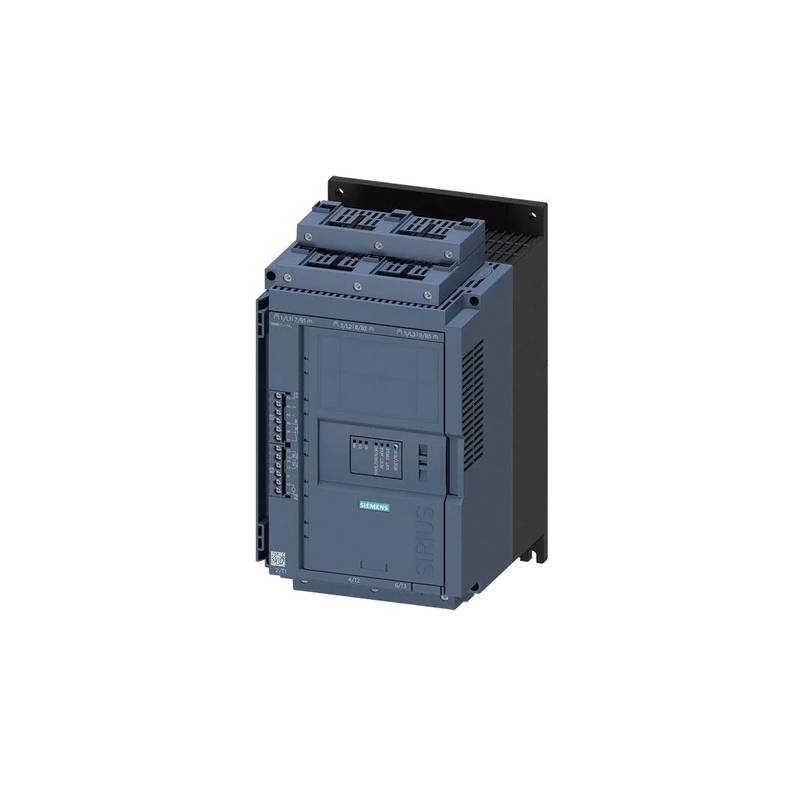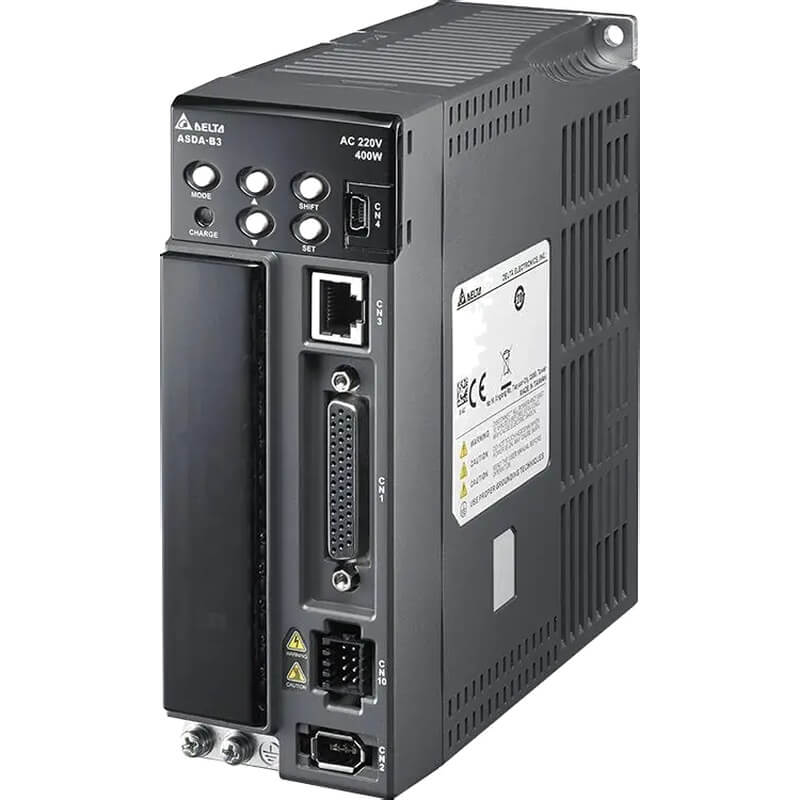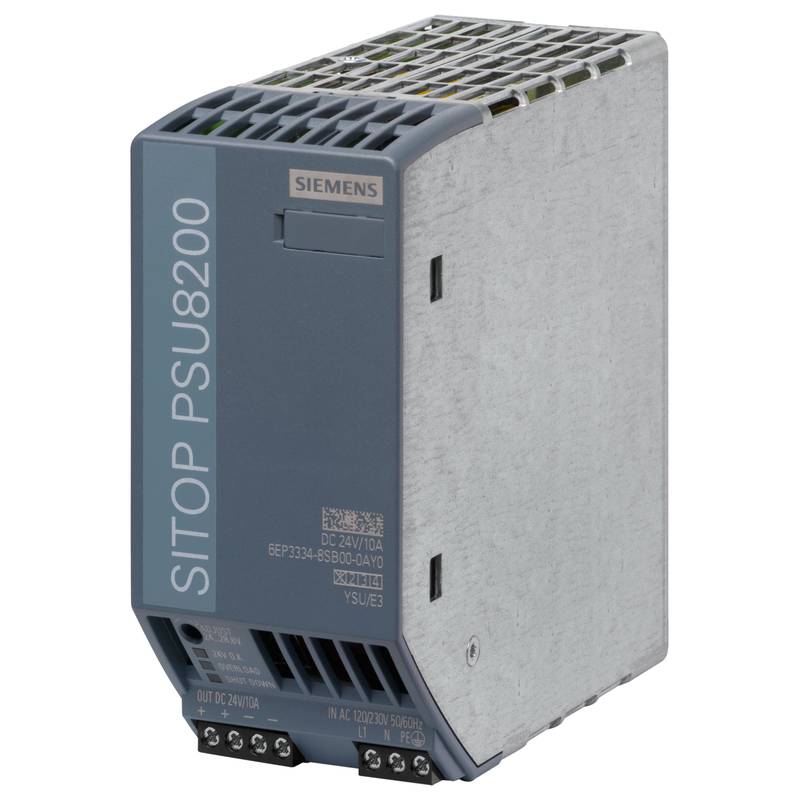
The INVT GD10-1R5G-S2-B Single-Phase Input Compact VFD offers a robust solution for precise motor control, boasting a 1.5kW (2HP) power rating and a versatile input voltage range of 200-240V single-phase. This compact variable frequency drive excels in delivering superior performance with its advanced sensorless vector control, ensuring excellent torque response and speed accuracy even under fluctuating loads. Key technical specifications include an output frequency of 0-400Hz, a nominal current of 7.0A, and integrated RS485 communication for seamless system integration. Its IP20 protection rating and efficient heat dissipation design make it suitable for demanding industrial environments, while its user-friendly interface simplifies operation and parameter configuration.
Core Features & Market Positioning
The INVT GD10-1R5G-S2-B distinguishes itself through its advanced sensorless vector control algorithm, providing exceptional dynamic performance and precise speed regulation, a feature typically found in higher-end drives. This capability significantly enhances operational efficiency and product quality in applications requiring tight control over motor speed and torque. Its compact footprint is a major advantage in space-constrained installations, allowing for flexible mounting options without compromising performance. The drive's robust design and reliability position it as a cost-effective yet high-performance alternative in the competitive VFD market, offering long-term value through energy savings and reduced mechanical wear on equipment.
Key Application Scenarios
This single-phase input VFD is ideally suited for a wide array of industrial and commercial applications where precise motor speed control is paramount. It finds extensive use in the food and beverage industry for conveyor systems, packaging machinery, and mixers, where consistent speed and torque are critical for process efficiency. In the textile industry, the GD10-1R5G-S2-B is employed in spinning machines and looms to maintain uniform fabric production. Its versatility also extends to water treatment plants for pump control, HVAC systems for fan speed regulation, and machine tool applications demanding accurate speed adjustments. The drive's ability to handle fluctuating loads makes it a reliable choice for equipment like extruders and centrifugal pumps.
Practical System Integration Guidance
Integrating the INVT GD10-1R5G-S2-B into existing systems is streamlined due to its user-friendly design and comprehensive communication options. For wiring, ensure the single-phase power supply (200-240V) is correctly connected to terminals L and N, and the motor is wired to terminals U, V, and W. Grounding should be established for safety. Parameter configuration is managed via the integrated keypad or through the RS485 interface using Modbus RTU protocol. Common programming involves setting motor parameters (P00.01 to P00.06), defining speed commands (e.g., P01.00 for keypad reference, P01.01 for analog input), and configuring acceleration/deceleration times (P02.00, P02.01). For optimal performance, sensorless vector control parameters (P03.00 series) should be tuned based on the connected motor's specifications.
Operation and Risk Mitigation
Safe and efficient operation of the INVT GD10-1R5G-S2-B requires adherence to standard industrial safety protocols. Before installation or maintenance, always disconnect power to prevent electrical shock. Ensure proper ventilation around the VFD to prevent overheating, as the IP20 rating signifies protection against solid objects larger than 12.5mm but not against moisture. Common troubleshooting involves checking error codes displayed on the keypad; for instance, an "OL" (Overload) fault might indicate an undersized motor or excessive load, requiring a review of motor parameters or mechanical system. An "OC" (Overcurrent) fault typically points to rapid acceleration or short circuits, necessitating a check of motor wiring and acceleration settings. Regular inspection of wiring integrity and motor performance helps mitigate potential risks and ensures continuous operation.
Scalability & Long-Term Value
The INVT GD10-1R5G-S2-B offers significant long-term value through its compatibility and integration capabilities, aligning with modern industrial automation trends. Its embedded RS485 communication port facilitates seamless integration into SCADA systems and other supervisory control platforms via the Modbus RTU protocol, enabling centralized monitoring and control. This makes it a scalable solution for expanding automation projects. While not designed for direct IIoT connectivity out-of-the-box, its communication interface allows it to be readily incorporated into IIoT architectures through intermediary gateways or PLCs. This ensures that investments in the GD10-1R5G-S2-B remain relevant as facilities upgrade to more connected and data-driven operational models, offering flexibility for future system enhancements.
Product Specifications
| Parameter | Specification |
| :------------------------ | :--------------------------------------------- |
| Model | GD10-1R5G-S2-B |
| Input Voltage | 200-240V Single-Phase |
| Output Power | 1.5kW (2HP) |
| Output Current (Nominal) | 7.0A |
| Output Frequency Range | 0-400Hz |
| Control Method | Sensorless Vector Control, V/f Control |
| Protection Rating | IP20 |
| Communication Interface | RS485 (Modbus RTU) |
| Dimensions (H x W x D) | 168 x 90 x 125 mm |
| Ambient Temperature Range | -10°C to +40°C |
| Mounting Type | Wall/Din Rail Mount |
Frequently Asked Questions
1. What types of motors can be controlled by the INVT GD10-1R5G-S2-B?
This VFD is designed to control standard three-phase asynchronous induction motors. It supports both Sensorless Vector Control (SVC) and Volts/Hertz (V/f) control methods. SVC offers superior torque control and dynamic response, ideal for applications with varying loads.
V/f control is simpler and suitable for applications where precise torque control is less critical, such as centrifugal fans or pumps. When using SVC, it's essential to accurately input the motor's nameplate data into the VFD parameters for optimal performance.
The drive is rated for 1.5kW (2HP) motors, and users should ensure the motor's power rating does not exceed this limit. Always verify the motor's voltage and frequency ratings are compatible with the VFD's single-phase 200-240V input and 0-400Hz output.
2. How do I connect the INVT GD10-1R5G-S2-B to a single-phase power source?
Connect your single-phase 200-240V AC power supply to the L and N terminals on the VFD's input side. Ensure the supply voltage is within the specified range for reliable operation. Always use appropriate circuit breakers and wiring sized for the VFD's input current.
For safety, ensure a proper earth ground connection is made to the ground terminal on the VFD. This is crucial for protecting against electrical faults and ensuring safe operation. Double-check all connections before applying power to prevent damage or hazards.
The output terminals, U, V, and W, are used to connect to your three-phase motor. Ensure these connections are secure and correctly wired according to the motor's specifications to achieve the desired rotation direction.
3. What are the advantages of using sensorless vector control on this VFD?
Sensorless vector control provides highly accurate speed regulation and excellent torque response, even at low speeds. This is crucial for applications requiring precise positioning or consistent performance under varying mechanical loads. It eliminates the need for motor-mounted encoders, simplifying installation and reducing potential failure points.
This advanced control method allows the VFD to maintain a stable output torque, preventing motor stalls when subjected to sudden load changes. This leads to smoother operation, reduced mechanical stress on the motor and driven equipment, and ultimately, increased system reliability and lifespan.
The improved dynamic performance also enables faster response to speed commands and load variations, optimizing process efficiency and reducing cycle times in applications like material handling, conveyors, and machine tools.
4. Can the INVT GD10-1R5G-S2-B be integrated into a larger automation system using RS485?
Yes, the GD10-1R5G-S2-B features an integrated RS485 communication port that supports the Modbus RTU protocol. This enables seamless integration with Programmable Logic Controllers (PLCs), Human-Machine Interfaces (HMIs), and other supervisory control systems.
Through Modbus RTU, you can remotely monitor VFD status, read operational parameters, and write control commands such as start/stop and speed setpoints. This facilitates centralized control and data acquisition in industrial automation environments.
This capability allows for comprehensive system diagnostics, remote troubleshooting, and efficient data logging, enhancing overall operational visibility and control in complex manufacturing or process control setups.
5. What common fault codes might I encounter with the INVT GD10-1R5G-S2-B?
Common fault codes include "OL" for Overload, indicating the motor is drawing more current than its rated capacity for an extended period, often due to mechanical binding or an undersized motor. "OC" signifies Overcurrent, typically occurring during rapid acceleration or due to a short circuit in the motor or wiring.
"UV" (Under-Voltage) and "OV" (Over-Voltage) faults relate to deviations in the input power supply voltage from the acceptable range, suggesting issues with the power source or voltage fluctuations. "E.OC" might indicate an Earth Leakage fault, signaling a problem with the motor insulation or grounding.
For each fault code, the VFD's manual provides specific diagnostic steps and recommended corrective actions, such as adjusting acceleration/deceleration times, verifying motor parameters, or checking external wiring and power supply stability.
6. How do I perform basic parameter setup for a new motor?
Begin by accessing the parameter menu and setting the fundamental motor parameters, typically found in the P00 group. This includes the motor's rated power (P00.01), rated frequency (P00.02), rated speed (P00.03), rated voltage (P00.04), and rated current (P00.05).
Accurate entry of these motor nameplate values is crucial, especially when using Sensorless Vector Control (SVC), as it allows the VFD to optimize its performance characteristics for the specific motor. Incorrect parameters will lead to suboptimal performance or potential fault conditions.
After setting motor-specific parameters, configure basic operational settings like acceleration/deceleration times (P02.00, P02.01) and maximum frequency (P00.07). Then, set the speed reference source (e.g., P01.00 for keypad, P01.01 for analog input) to enable control.
7. What is the maximum output frequency supported by this VFD?
The INVT GD10-1R5G-S2-B supports a maximum output frequency of 400Hz. This wide frequency range allows for precise speed control across various applications, from low-speed operation to high-speed motor performance.
This high output frequency capability is particularly beneficial for applications requiring variable speed drives for machinery that needs to operate at speeds significantly higher than standard mains frequency (50/60Hz). Examples include high-speed spindles in machine tools or certain types of fans and pumps.
Users can set the maximum frequency via parameter P00.07. It's important to ensure that the connected motor is also rated to operate safely and effectively at the desired output frequencies, and that the VFD's cooling capacity is sufficient for extended operation at high frequencies.
8. Does the INVT GD10-1R5G-S2-B require a specific type of motor?
The GD10-1R5G-S2-B is designed to control standard three-phase asynchronous induction motors. It is not compatible with single-phase motors, permanent magnet synchronous motors (PMSM), or brushless DC motors without additional external hardware or specific configuration.
When using the advanced Sensorless Vector Control (SVC) mode, it is critical to input the specific parameters of the connected three-phase motor, such as its rated power, voltage, current, frequency, and speed, into the VFD. Accurate parameterization ensures optimal performance and protection.
For standard V/f control, the VFD can operate with a wider range of three-phase motors, but precise torque control and low-speed performance will be reduced compared to SVC. Always ensure the motor's voltage rating matches the VFD's output capabilities.
9. What are the installation requirements for this VFD?
The INVT GD10-1R5G-S2-B has an IP20 protection rating, meaning it should be installed in a clean, dry environment, protected from dust, moisture, and excessive vibration. It is designed for mounting on a vertical surface or a DIN rail.
Adequate ventilation is crucial to prevent overheating. Ensure there is sufficient clearance around the VFD, typically at least 50mm on the sides and 100mm above and below, to allow for proper air circulation. Avoid installing it in enclosed cabinets without forced ventilation.
The ambient operating temperature range is -10°C to +40°C. If operating in higher ambient temperatures, derating of the VFD's output current capacity may be necessary. Follow all local electrical codes and safety regulations during installation.
10. How can I adjust the acceleration and deceleration times?
Acceleration and deceleration times are critical parameters that determine how quickly the motor speeds up or slows down when a speed command changes. These are typically set using parameters P02.00 for acceleration time and P02.01 for deceleration time.
These parameters are usually set in seconds. For example, setting P02.00 to 5.0 means the motor will accelerate from 0Hz to its target frequency (e.g., 50Hz) over a period of 5 seconds. Shorter times provide quicker response but can increase current draw and stress on the motor.
Adjusting these times based on the application's requirements is essential for smooth operation and to prevent nuisance tripping due to overcurrent or overvoltage faults during rapid changes in motor speed. Gradual acceleration and deceleration are generally preferred to prolong equipment life.

























